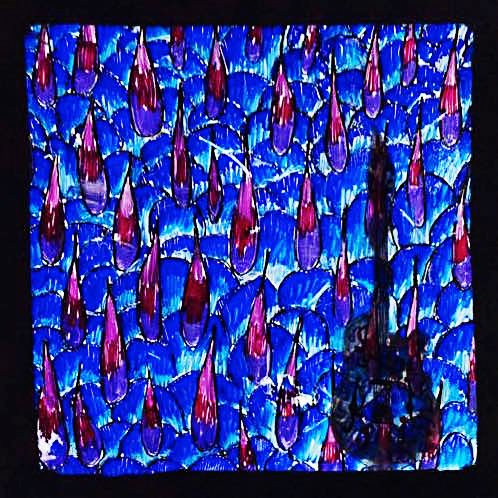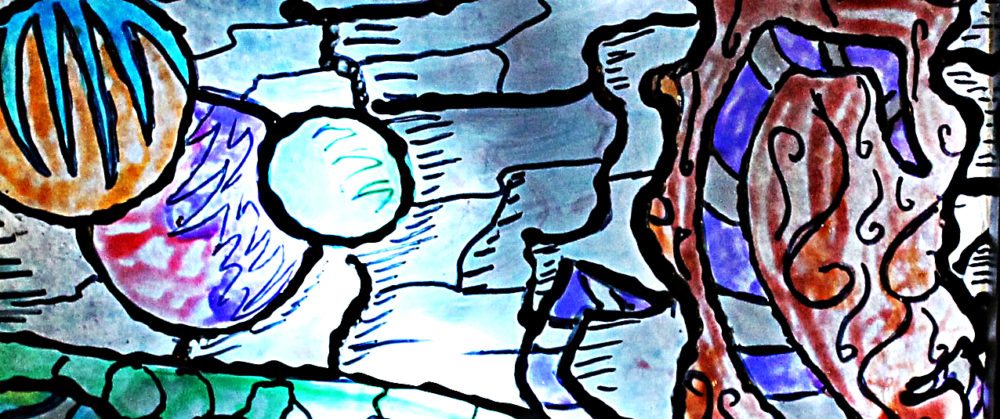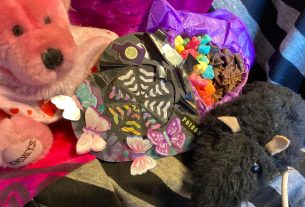
The Artists: Clara Driscoll and Louis Comfort Tiffany
There is no argument that Louis Comfort Tiffany was an amazing artist, whose stained glass lamps, windows, mosaics, and other works helped define the entire look of the Art Nouveau movement.
His own company, best known as Tiffany Studios, operated from 1878 to nearly 1930, and its more than 300 artisans are responsible for some of the most beautiful windows for churches, hotels, and other buildings throughout the nation. This included installations for the White House commissioned by President Chester Arthur.
Today, a newer Tiffany Studios continues to create more obtainable reproductions of the original studio’s work.
However, one of his secret weapons was a glass artist and designer named Clara Driscoll. Driscoll supervised Tiffany’s Womens’ Glass Cutting Department, often referred to as the “Tiffany Girls.”
Driscoll was born in 1861. Her father died when she was 12. She and her sisters were some of the few women of the time encouraged to pursue a higher education, and she found herself drawn to the visual arts. After attending Western Reserve School of Design for Women, now Cleveland Institute of Art, she worked in furniture making. She also continued her education at the Metropolitan Museum Art School. It was there Tiffany discovered her.
She was a widow—married women were not allowed to work at the studio—so she was hired on. She worked for Tiffany for more than 20 years until she remarried in 1909, and may have been one of the highest paid women of her time. She earned $10,000 a year with Tiffany Studios.

It is likely, as a matter of fact, that anyone who has had the opportunity see one of Tiffany Studios’ famous floral lamps is seeing a pattern designed by Driscoll and her department’s artists. At the time, however, she didn’t get the credit for her work.
As recent as 2002, it had been discovered she was the designer behind one of Tiffany’s most iconic designs, the Dragonfly lampshades. It really was not until around 2006 a researcher and history professor named Martin Eidelberg was able to confirm, through a series of correspondence between Tiffany and Driscoll, her department was responsible for many of the studios’ lamps.
In 2007, Eidelberg, Nina Gray and Margaret Hofer released the book A New Light on Tiffany: Clara Driscoll and the Tiffany Girls, which “presents celebrated works of Tiffany Studios in an entirely new context, focusing on the women who labored behind the scenes to create the masterpieces now inextricably linked to the Tiffany name.”
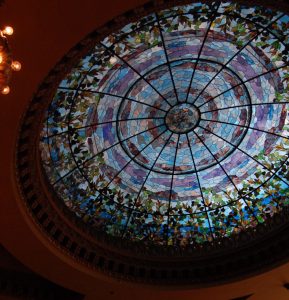
This window at Camino Real Hotel in El Paso is once once credited to him, but his involvement has never been confirmed. Photo by Rick Tate.
Today, many more people now know about Driscoll’s invaluable contributions to Tiffany’s work, but there were around 300 artisans who helped make Tiffany Studios as famous as it was.
One thing Tiffany himself was very aware of is that just because works of art can be made into a successful business venture, it doesn’t have to lose it artistic merit. He has been often credited with the following quote indicating artists don’t have to be starving to be significant.
“Go after the money there is in art, but the art will be there just the same,” he said.
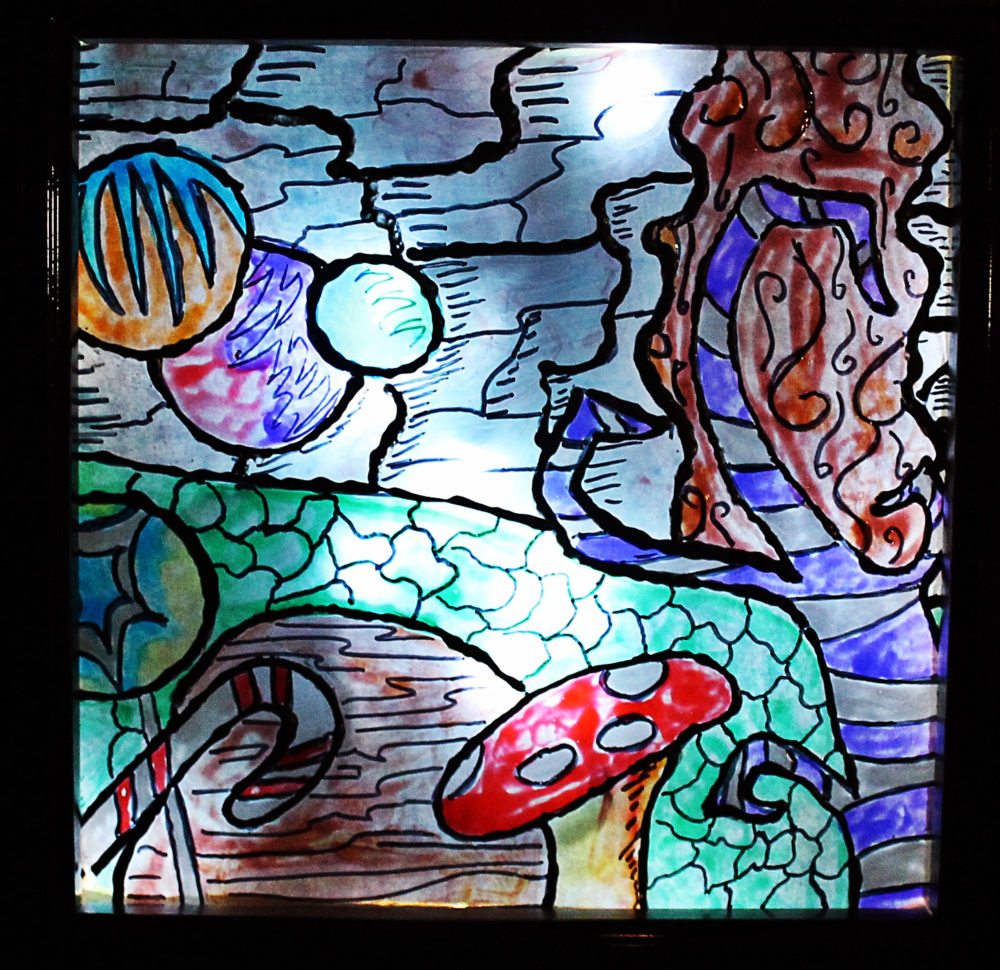
The Project: Geeky little “Windows”
One of the most beautiful things about most glass art is its relationship to light, either natural or artificial.
For this project, we’ll be making some easily illuminated shadowboxes in the spirit of Driscoll, Tiffany, and all the Tiffany artists’ designs.
You Need:
• A shadowbox frame with glass or small gift box (like a necklace or tie box)
• Shrink art paper (if using gift boxes)
• A small string battery-operated LED lights OR little LED balloon or lantern lights for smaller, ring-size boxes. These can be purchased at party or craft stores.
• Transparent or sun paints (for glass shadowboxes)
• Black or metallic puff paint
• Felt tip markers (for gift boxes)
Tiffany’s window were created for beauty, and they were sometimes for celebration or sometimes for memorial. I was planning some Tim Burton-style designs for this project, but with the recent death of the original Willy Wonka, Gene Wilder, my daughters and I decided to create a set of memorials for some of the far too many amazing talents who were victims of 2016.

First, you need an image.
Use simple photographs, color book pictures, or draw your own idea on a piece of blank paper.
Next, place the glass, and use felt tip marker to trace the outline of the image as you want it. Then, use the paints or markers to color in the image, just like a color book.
If using shrink art sheets, shrink per the instructions on the package, after coloring and sizing the image for the box. The rule is shrink paper fizzles down to 1/3 of the original size, so measure your box first.
Go over the outlines of the glass image carefully with the puff paint. Wait until shrink art is already cooked and shrank when using those.
For the glass shadowbox frame: Reinsert the glass into the frame. Tape, glue, or use small wire staples (found at most home stores) and arrange the lights evenly around the inside back of the frame. Some small LED sets have a small enough battery pack to keep inside the box, or you can drill a small hole in the back of the frame if you want to get to it easier.
For the gift box frames: Using a small utility or hobby knife, cut a frame like hole in the lid of the box, leaving a small amount around the edge. Paint the box, if you want, before inserting the design on the inside of the frame. Add lights similar to the glass frame or the small LED lantern light in the center back of the box.

Place these finished boxes on shelves, bed stands, or other areas where you want a little color and illumination.
Use as much color as you want, regardless of how much the original image has. The bold use of color is one of the things that made Tiffany, Driscoll, and the other studio artists’ work so memorable.
“Color is to the eye what music is to the ear,” Tiffany said.
